In the ever-evolving landscape of digital enterprises, the need for robust observability is paramount. CEOs, CIOs, and CMOs are at the forefront of driving innovation and ensuring the seamless operation of their organizations. In this era of complex and dynamic software architectures, achieving a deep understanding of system behavior is not just advantageous but often critical. This is where OpenTelemetry emerges as a game-changer, offering a comprehensive solution to the challenges of observability.
Unlocking the Power of OpenTelemetry

Embracing a New Era of Observability
Observability is not just a buzzword; it's a necessity for organizations navigating the intricacies of modern software systems. It's the ability to gain insights into your applications' performance, troubleshoot issues in real-time, and optimize user experiences. OpenTelemetry, an open-source project under the Cloud Native Computing Foundation (CNCF), is designed to empower businesses by providing a standardized approach to collecting, processing, and exporting telemetry data.
The Core Components of OpenTelemetry
OpenTelemetry comprises a set of core components that seamlessly integrate into your existing software stack. From instrumenting your codebase to collecting and exporting telemetry data, OpenTelemetry simplifies the observability journey. With support for multiple programming languages and frameworks, it offers a universal solution for organizations with diverse technology stacks.
Advantages of OpenTelemetry
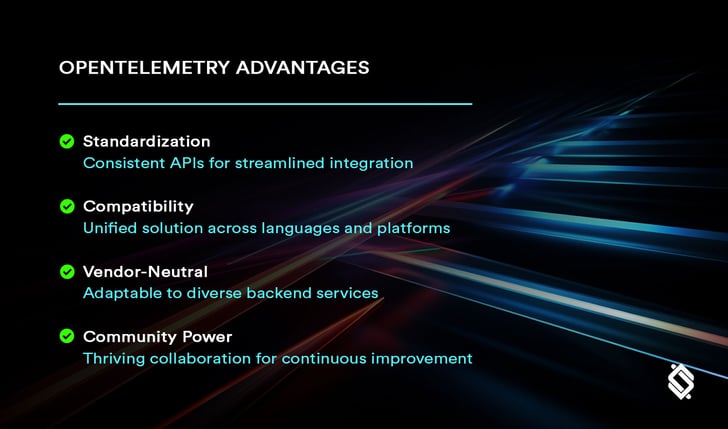
Standardization of Instrumentation
One of the primary challenges in achieving observability is the inconsistency in instrumentation across different services and applications. OpenTelemetry addresses this by providing a standardized set of APIs and libraries, ensuring uniform instrumentation practices. This standardization not only streamlines the integration process but also enhances collaboration across development teams.
Cross-Language and Cross-Platform Compatibility
In a multi-language and multi-platform environment, having a unified observability solution is crucial. OpenTelemetry's cross-language compatibility allows organizations to instrument applications written in various programming languages, providing a holistic view of their entire ecosystem. Whether your organization relies on Java, Python, Go, or any other language, OpenTelemetry has you covered.
Vendor-Neutral Approach
Vendor lock-in can be a concern when adopting new technologies. OpenTelemetry mitigates this risk by adopting a vendor-neutral approach. It supports a wide range of backend services, allowing organizations to choose the monitoring and tracing systems that best fit their needs. This flexibility ensures that your investment in observability remains adaptable to future changes in your technology stack.
Community Collaboration and Support
OpenTelemetry is not just a tool; it's a thriving community. With contributions from industry leaders and passionate developers, the project benefits from diverse perspectives and experiences. This collaborative approach results in a robust and continuously evolving observability solution. As a CEO, CIO, or CMO, being part of this community means having a say in shaping the future of observability.
Integration with Existing Systems
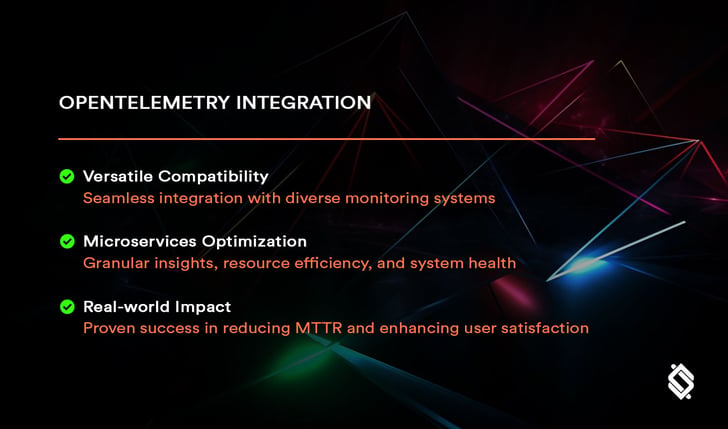
Compatibility with Various Monitoring and Tracing Systems
The seamless integration of OpenTelemetry with various monitoring and tracing systems is a testament to its versatility. Whether your organization is using industry-standard solutions like Prometheus and Grafana or custom-built systems, OpenTelemetry ensures compatibility. This interoperability simplifies the process of consolidating observability data and facilitates a unified view of your entire infrastructure.
Implementation in Microservices Architectures
For organizations embracing microservices architectures, OpenTelemetry is a boon. It allows for instrumentation at the service level, enabling granular insights into the performance of each microservice. This level of detail is invaluable for identifying bottlenecks, optimizing resource utilization, and ensuring the overall health of your microservices ecosystem.
Real-world Use Cases and Success Stories
The impact of OpenTelemetry extends beyond theoretical advantages. Real-world use cases and success stories highlight how organizations have overcome complex observability challenges with OpenTelemetry. From reducing mean time to resolution (MTTR) to improving end-user satisfaction, these stories illustrate the tangible benefits of integrating OpenTelemetry into your organization's tech stack.
1. Financial Services Transaction Monitoring
Challenge: A financial institution grappled with identifying latency issues in their transaction processing system, impacting customer trust and satisfaction.
Solution: OpenTelemetry was deployed to provide granular insights into transaction processing times, allowing the institution to identify specific services causing delays.
Result: A 25% decrease in transaction processing time, resulting in improved customer satisfaction and trust in the financial services provided.
2. Media Streaming Platform Optimization
Challenge: A popular media streaming platform faced difficulties in maintaining a seamless streaming experience for users, with intermittent buffering affecting user engagement.
Solution: OpenTelemetry was implemented to trace the performance of each microservice involved in the streaming process. This allowed the platform to identify and address latency issues impacting the user experience.
Result: A 40% reduction in buffering incidents, leading to a significant increase in viewer retention and overall satisfaction with the streaming service.
Improving Performance and Troubleshooting
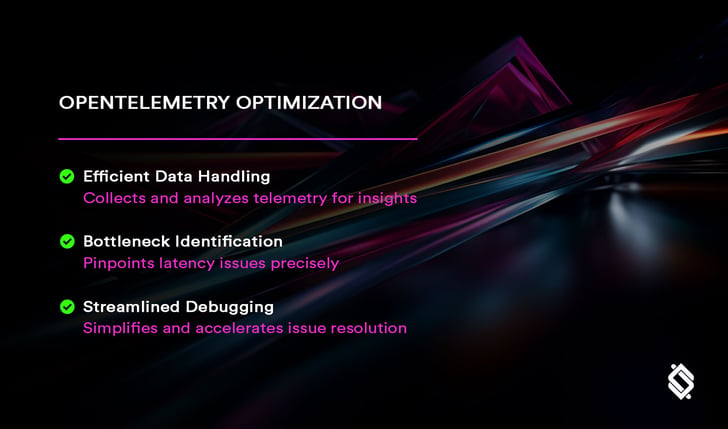
Efficient Data Collection and Analysis
In the pursuit of optimal performance, data is key. OpenTelemetry excels in efficiently collecting and analyzing telemetry data, providing actionable insights into your applications. From identifying performance bottlenecks to understanding user behavior, the data collected by OpenTelemetry becomes a valuable asset in your quest for continuous improvement.
Identifying Bottlenecks and Latency Issues
Latency can be the Achilles' heel of digital services. OpenTelemetry's granular instrumentation allows for pinpointing bottlenecks and latency issues with precision. By understanding where delays occur in your system, you can proactively address performance challenges, enhancing the overall user experience and maintaining a competitive edge.
Streamlining Debugging Processes
Rapid and effective debugging is crucial in minimizing downtime and ensuring a seamless user experience. OpenTelemetry simplifies the debugging process by providing detailed traces and logs. This aids developers in quickly identifying the root cause of issues and implementing timely solutions, reducing the impact on your organization's operations.
OpenTelemetry Best Practices
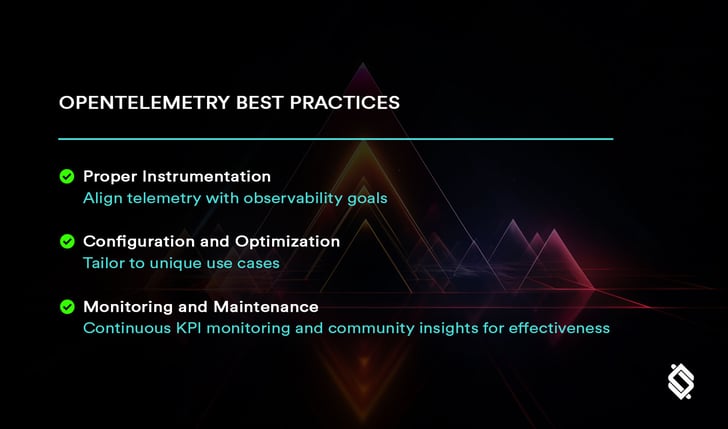
Proper Instrumentation Strategies
Effectively implementing OpenTelemetry requires meticulous consideration of organizational needs. Best practices serve as a guiding compass, ensuring that the telemetry data collected aligns seamlessly with the overarching observability goals. By intricately tailoring the instrumentation approach to the unique intricacies of the organization, OpenTelemetry becomes a powerful ally in deciphering and enhancing system performance.
Configuring and Optimizing OpenTelemetry for Specific Use Cases
The true prowess of OpenTelemetry unveils itself when tailored to specific organizational use cases. Whether the challenge is handling massive scale, ensuring lightning-fast responses, or meeting stringent security standards, the configuration and optimization of OpenTelemetry become pivotal. This strategic alignment not only maximizes its benefits but elevates OpenTelemetry into a bespoke solution, finely tuned to address the distinctive needs of the organization's digital ecosystem.
Monitoring and Maintaining the OpenTelemetry Implementation
Observability is not a one-time accomplishment; it's an ongoing process that demands continuous attention. Employing robust strategies for perpetual monitoring, tracking key performance indicators, implementing automated alerts, and staying abreast of the vibrant OpenTelemetry community are integral to sustaining the effectiveness of the implementation. Through these proactive measures, organizations ensure that their observability solution evolves in tandem with the ever-changing digital landscape.
Future Developments and Roadmap
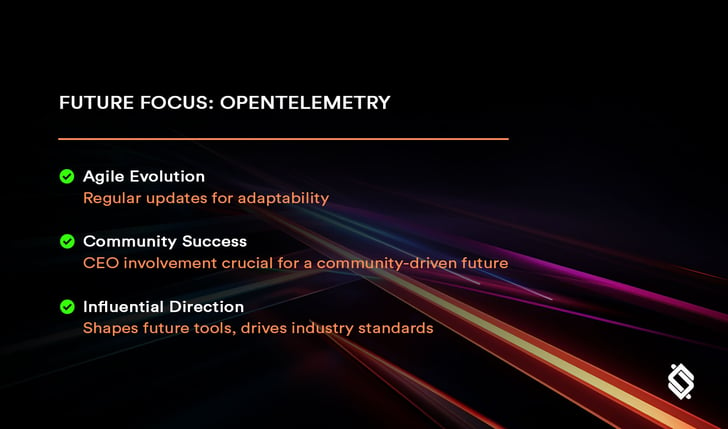
Ongoing Enhancements and Updates
The evolutionary journey of OpenTelemetry is characterized by a constant influx of enhancements and updates. Staying abreast of the latest features and improvements is not just a matter of keeping pace; it's a strategic imperative. Organizations that remain informed position themselves to strategically plan their observability roadmap, leveraging the cutting-edge capabilities that continuous evolution brings to the OpenTelemetry ecosystem.
Community Involvement and Contributions
Beyond being a tool, OpenTelemetry thrives as a dynamic community endeavor. Actively engaging in the OpenTelemetry community, be it through contributing code, sharing insights, or participating in discussions, is more than a participation—it's a declaration of influence. Organizations, represented by their CEOs, CIOs, and CMOs, become active architects in shaping the development trajectory of future OpenTelemetry versions.
Potential Impact on the Future of Observability
OpenTelemetry is not just a player; it's a game-changer in the realm of observability. Its influence extends beyond individual systems, shaping tools, and driving industry standards. As organizations increasingly rely on OpenTelemetry, its trajectory becomes synonymous with the trajectory of the future of observability. CEOs, CIOs, and CMOs leveraging OpenTelemetry aren't just adopting a solution; they are architects of a future where monitoring and optimizing digital services transcend existing boundaries.
Challenges and Considerations
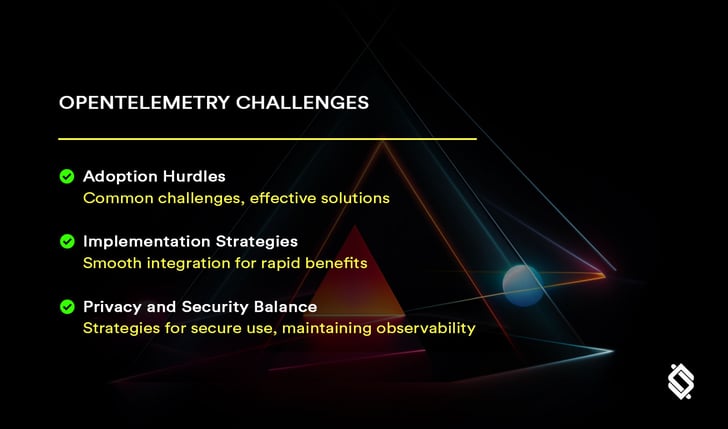
Common Challenges in Adopting OpenTelemetry
Despite the undeniable benefits OpenTelemetry brings, the journey of adoption is not without its challenges. These challenges are not roadblocks but rather stepping stones. Effective strategies for mitigating these challenges are not just desirable; they are imperative for the successful integration of OpenTelemetry into the organizational fabric.
Strategies for Overcoming Implementation Hurdles
Navigating the implementation phase of OpenTelemetry is akin to orchestrating a symphony. It demands a blend of precision and artistry. Practical strategies for overcoming common hurdles are not just a roadmap; they are the conductor's baton, ensuring a harmonious integration process and the rapid realization of observability benefits.
Balancing Observability with Privacy and Security Concerns
In the pursuit of observability, the balance between insights and safeguarding sensitive information is delicate. Striking the right equilibrium is not just a skill; it's an art form. Proactive strategies addressing privacy and security concerns are not just precautions; they are the guardians ensuring that organizations can confidently leverage OpenTelemetry without compromising the integrity of their digital operations.
Conclusion

In conclusion, OpenTelemetry isn't merely a tool; it's a transformative force shaping the future of observability. CEOs, CIOs, and CMOs navigating the digital landscape aren't just leveraging OpenTelemetry; they are orchestrators of a symphony of observability, positioning their organizations not just for success but for leadership in the evolving digital realm.



